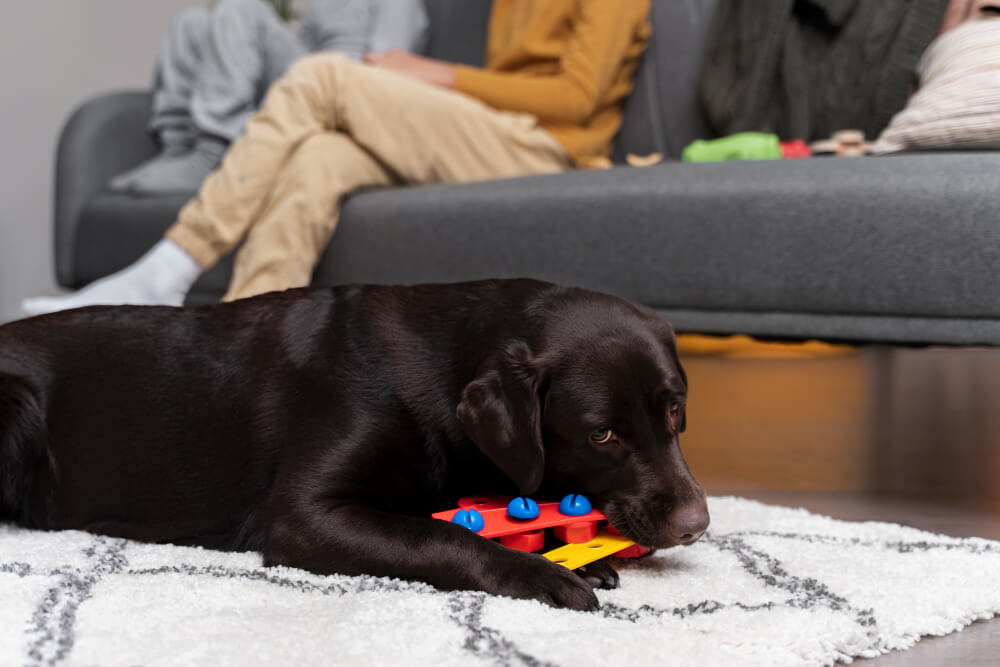If your dog can't stand to visit the dog park or shies away from your touch, you might wonder if they have autism. However, the autism spectrum comes with a variety of symptoms. Some are mild, allowing individuals to live by themselves. Meanwhile, others need carers. Additionally, it has many symptoms that overlap with other conditions which can lead to a misdiagnosis or an overlooked disease.
In this blog, you'll discover which signs indicate that you may have an autistic dog and what you should do about it.
What Is Autism?

Autism is a spectrum of disorders that some humans can exhibit. It stems from a difference in the nervous system. The spectrum of these disorders encompasses different levels of severity and symptoms of neuro-divergence. It's a congenital condition, meaning that it's present from birth and isn't caused by an infection, injury, medication, or vaccines.
Furthermore, it affects how the person behaves, reacts to stimuli, processes information, and learns. In particular, those with autism can display repetitive motions and obsession with certain interests. Additionally, they can have difficulty understanding cues, emotions, and social situations. All these behaviors fall out of the norm of neuro-typical humans.
Can Dogs Get Autism?
While dogs can show similar behavior as autistic humans, they can't have autism. Instead, they can have the congenital condition: Canine dysfunctional behavior. This condition was first researched by veterinarians in the 1960s.
Unlike autism, this condition in dogs isn't a spectrum. Usually, it comes with a set of symptoms that a veterinarian can use to diagnose them. It might be due to a lack of the neurons that help younger dogs learn social norms from older dogs.
The Signs of Autism in Dogs

Though more veterinarians and dog owners are becoming aware of canine dysfunctional behavior, it's not a simple condition to assess. To better recognize this condition, let's dive into the symptoms and signs of this condition.
-
Avoiding Interactions
You might notice autism in dogs by looking for antisocial behavior. Dogs with this dysfunctional behavior don't want to come into contact with other dogs or humans. Your pet may refuse to greet humans, refuse to enter dog parks, and avoid eye contact. Your dog might not even pay attention to you in situations when neuro-typical dogs normally would, such as when you're playing with them or feeding them.
-
Staring in a Trance
Another sign you have an autistic dog is if it stares for long periods without a clear reason. Of course, it's normal for your dog to perk up and look around for a few seconds. They might have detected a stimulus even if you haven't heard or smelled what they have.
However, a neurotypical pet wouldn't stare in a trance, especially not when they should be happy and giving you their attention. A dog with this dysfunctional behavior may not wag their tail when they're happy or flit their ear back when you reprimand them. Instead, your pet will stare in a trance.
-
Repetitive Behavior
One of the obvious dog autism symptoms is repetitive behavior. Dogs will usually do some activities for a while such as gnawing on a toy or occasionally chasing their own tail. However, dysfunctional behavior would compel them to compulsively do these actions:
- Walking/Running in a Circle
- Chasing Its Own Tail
- Grinding Its Teeth
- Chewing
This 'stimming' behavior is also present in autistic people. It's a way for those with the condition to calm themselves down. Alternatively, it could be a sign that your pet is anxious.
-
Hypersensitivity
Just as humans with autism can be sensitive to textures, smells, sounds, lights, and tastes, so can your dog. More specifically autism for dogs can translate into a reaction to a stimulus that's atypical for dogs. For instance, if you try to pet your dog, they might bark or whine in pain. Their ears might even flit back like they're fearful or aggressive.
Furthermore, your dog may decide to avoid new environments to prevent exposure to stimuli they're unfamiliar with. If your pet does end up in a situation that they react to poorly, it may retreat to a place they feel comfortable in.
-
Fatigue
Lastly, fatigue is a symptom of autism in dogs. Due to the increased distress and the repetitive motions your pet exhibits, if they have this dysfunctional behavior, they use up their energy. Therefore, even if they're a high-energy dog such as an American Pit Bull Terrier or a Siberian Husky your pet may be lethargic and avoid physical activities.
However, it could also be another medical condition so you should bring your dog to a pet to rule it out. Additionally, you should consider your dog's breed. Some breeds such as Great Dane and Saint Bernard are naturally calm dogs.
How to Care for Autistic Dogs

Though there is no cure for this dysfunctional behavior, with patience and care, you can help your dog live a happy life. More specifically, you should:
- Establish a Diagnosis: If you notice your dog shows the above signs, you should take them to a vet. They'll rule out other conditions such as anxiety and let you know if your pet has this condition.
- Train Your Dog: With patience and a trainer who has expertise with autistic dogs, teach your pet commands and create positive reinforcement.
- Study Your Dog: To allow your dog to live a stress-free life, you'll need to learn what makes your pet react poorly and what stimuli they prefer. For instance, they may prefer hikes as opposed to crowded dog parks.
- Plan Activities: Whether a friend is visiting or you want to go on a trip, you should prepare ahead of time to make it as stress-free as possible.
- Medicate Your Dog: There is a medication that helps dogs with autism reduce their repetitive and aggressive behavior.
- Give Your Dog a Balanced Diet: You should consult a veterinarian to plan a balanced diet that could help your dog manage their condition easily.
- Exercise Your Dog: Though your pet might be lethargic, they still need regular exercise. Therefore, you should take them on walks or play with them in ways that don't stress them.
- Reduce Your Dog's Stress: You should give your dog a space to retreat. It should have no strong stimuli such as strange smells or sounds. Additionally, you should include weighted blankets. Their calming pressure might help reduce their stress.
Conclusion
Understanding the signs of autism in dogs is crucial for their well-being. Dogs with this condition exhibit behaviors that are markedly different from what's typical for their breed, indicating a potential for canine dysfunctional behavior. Such signs include an unusual lack of eye contact, disinterest in playing with other dogs, and not wagging their tail in situations where they would normally be expected to show happiness. Recognizing these atypical behaviors early can alleviate stress for your pet by allowing you to seek timely management and support. Therefore, if you observe any unusual behaviors in your dog, it's important to consider these signs and consult with a veterinarian for a proper diagnosis.




